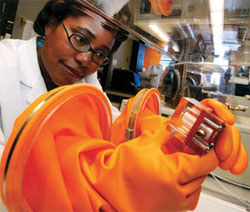New material helps increase efficiency and decrease cost of fuel cells
 Washington, October 19 : Chemists at the University of Calgary (U of C), Canada, have discovered a new material that can help increase the efficiency and decrease the cost of fuel cells.
Washington, October 19 : Chemists at the University of Calgary (U of C), Canada, have discovered a new material that can help increase the efficiency and decrease the cost of fuel cells.
U of C chemists Jeff Hurd and George Shimizu found a new material that allows a PEM fuel cell, known as a polymer electrolyte membrane fuel cell, to work at a higher temperature.
This discovery is extremely important in terms of increasing the efficiency and decreasing the cost of PEM fuel cells.
“This research will alter the way researchers have to this point perceived candidate materials for fuel cell applications,” said Shimizu a professor in the Department of Chemistry at the University of Calgary.
A fuel cell is an electrochemical energy conversion device which converts the chemicals hydrogen and oxygen into water and electrical energy.
Water usually carries the ions (protons) in a hydrogen fuel cell but this research uses higher boiling molecules trapped in a molecular scaffolding.
Currently, PEM fuel cells can produce energy from hydrogen below 90 degree Celsius, just under the boiling point of water.
With Shimizu’s material, energy can be produced at a higher temperature, up to 150 degree C.
This could ultimately make the fuel cell cheaper to produce because at a higher temperature less expensive metals can be used to convert hydrogen into energy.
Currently, platinum is used which is extremely expensive. Also, reactions at a higher temperature would be faster thus increasing efficiency.
“Ours is an entirely new approach that strikes a balance between having a regular molecular structure and mobile components all while showing genuine promise of application,” said co-author Hurd, a PhD candidate studying chemistry at the U of C.
Kevin Colbow, director of research and development at Ballard Power Systems, a company that designs and manufactures clean energy hydrogen fuel cells, calls the work significant.
“We believe that further improvement on conductivity and robustness of these materials could provide next generation membranes for PEM fuel cells,” he said. (ANI)